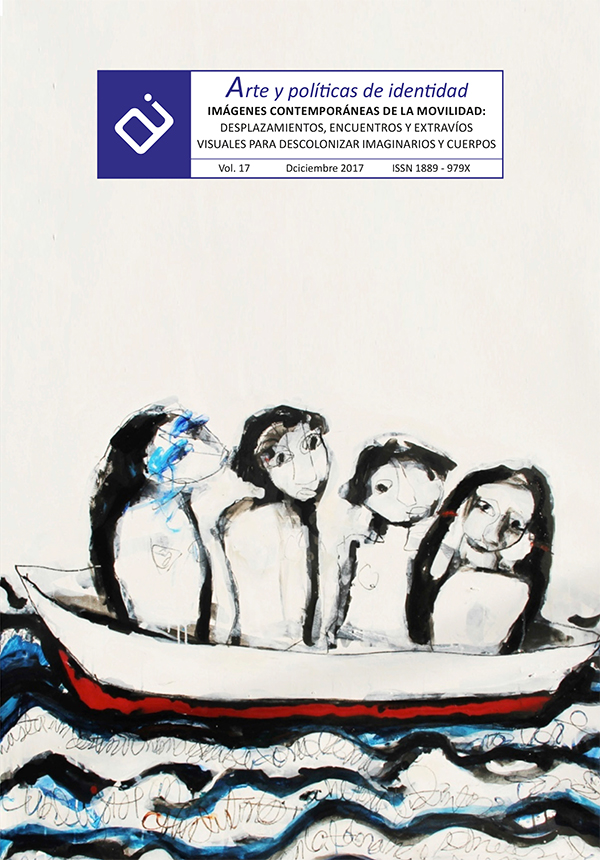Go’ zallik. And where are the men?
Flowered dresses and gender in Uzbekistan
Abstract
This article exposes the results of a research stay carried out during the month of August 2016 at the University of Samarkand (Uzbekistan). The result was a visual research synthesized in a mural photographic-sculptural piece, using images of the habits and customs of the citizens of that country, particularly of women, captured in previous days while travelling the country. The photographic installation was presented by the artist and researcher Inmaculada Abarca, in the School of Agronomic Engineering of the aforementioned city. The study presented here describes how the conception of the whole work, the result of the research allows approaching, from a critical and creative point of view and not only as an spectator, a culture deeply latent in the Western cultural imaginary due to the historical transcendence of the Silk Road. The title of this article refers to the question expressed by some observers, teachers and students of the Center where the artwork was installed, noting that in the exposed images that made up the photographic installation, only women, floral decorations, and flowers or natural plant elements, appeared. The former mentioned Faculty is a place linked to the rural environment and not directly related to art, however, students participated as helpers to the artist while mounting the installation, thereby awareness was triggered among the visitors about the identity of Uzbek women and their place in society, through the uses of women’s clothing and household items present in the daily life of Uzbeks.
Downloads
-
Abstract352
-
PDF (Español (España))296
References
Bachelard, G. (2002). El aire y los sueños. Ensayo sobre la imaginación del movimiento. México, D. F.: Breviarios del Fondo de Cultura Económica.
Bataille, G. (2007). El lenguaje de las flores. Exit, 28: 108-117.
Bourdieu, P. (2006). La dominación masculina. Barcelona: Anagrama.
Caerols, R. (2013). La praxis del artista: un enfoque desde la docencia y la investigación. Cuadernos de Bellas Artes (18), pp. 15-43. Recuperado dehttp://www.revistalatinacs.org/067/cuadernos/CBA.html#18
De Souza, B. (2010). Decolonizar el saber, reinventar el poder. Montevideo: Trilce.
Eco, U. (1972). El hábito hace al monje. En Alberoni, F., Dorfles, G., Eco, U., Livolsi, M., Lomazzi, G., Sigurta, R. Psicología del vestir. (pp. 8-23) Barcelona: Lumen.
García, N. (2010). ¿De qué hablamos cuando hablamos de resistencia?. Artes Visuales (6), pp.15-37. Recuperado de http://estudiosvisuales.net/revista/pdf/num7/02_canclini.pdf
Giddens, A. (2007). Sociología. Madrid: Alianza Editorial.
Gillow, J. y Sentance, B. (2000) Tejidos del mundo. Guía visual de las técnicas tradicionales. Guipúzcoa: Nerea.
González de Clavijo, R. (1999). Embajada a Tamorlán. Madrid: Clásicos Castalia. Rivera, S. (2010). Ch’ixinakax utxiwa Una reflexión sobre prácticas y discursos descolonizadores. Buenos Aires: Tinta Limón.
Works published in this journal are subject to the following terms:
- The Service of Publications from the University of Murcia (publishing house) keeps the published works’ copyrights, and favors and allows the reuse of these works under the license indicated in point 2.
- Works are published in the journal’s online edition under the license Creative Commons Reconocimiento-NoComercial-SinObraDerivada 3.0 España(texto legal). They can be copied, used, disseminated, transmitted and publicly exhibited, as long as: i) the author and original source of publication are cited (journal, publishing house and work’s URL); ii) they are not used for commercial purposes; iii) the existence and specifications of this license are mentioned.
3. Conditions for auto-file. It is allowed and encouraged that authors share electronically their pre-print version (the pre-reviewed version) and /or post-print version (the reviewed and accepted version) of their Works before the publication, since it promotes its circulation and dissemination. RoMEO color: green.










